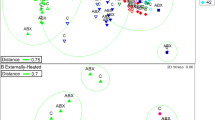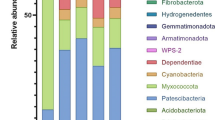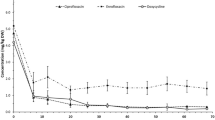Abstract
The use of antimicrobials in food animal production leads to the development of antimicrobial resistance (AMR), and animal manure constitutes the largest reservoir of such AMR. In previous studies, composted swine manure was found to contain substantially lower abundance of AMR genes that encode resistance to tetracyclines (tet genes) and macrolide–lincosamide–streptogramin B (MLSB) superfamily (erm genes), than manures that were treated by lagoons or biofilters. In this study, temporal changes in AMR carried by both cultivated and uncultivated bacteria present in swine manure during simulated composting and lagoon storage were analyzed. Treatments were designed to simulate the environmental conditions of composting (55°C with modest aeration) and lagoon storage (ambient temperature with modest aeration). As determined by selective plate counting, over a 48-day period, cultivated aerobic heterotrophic erythromycin-resistant bacteria and tetracycline-resistant bacteria decreased by more than 4 and 7 logs, respectively, in the simulated composting treatment while only 1 to 2 logs for both resistant bacterial groups in the simulated lagoon treatment. Among six classes each of erm and tet genes quantified by class-specific real-time PCR assays, the abundance of erm(A), erm(C), erm(F), erm(T), erm(X), tet(G), tet(M), tet(O), tet(T), and tet(W) declined marginally during the first 17 days, but dramatically thereafter within 31 days of the composting treatment. No appreciable reduction of any of the erm or tet genes analyzed was observed during the simulated lagoon treatment. Correlation analysis showed that most of the AMR gene classes had similar persistence pattern over the course of the treatments, though not all AMR genes were destructed at the same rate during the treatments.



Similar content being viewed by others
References
Chen J, Fluharty FL, St-Pierre N, Morrison M, Yu Z (2008) Technical note: Occurrence in fecal microbiota of genes conferring resistance to both macrolide–lincosamide–streptogramin B and tetracyclines concomitant with feeding of beef cattle with tylosin. J Anim Sci 86:2385–2391
Chee-Sanford JC, Mackie RI, Koike S, Krapac IG, Lin YF, Yannarell AC, Maxwell S, Aminov RI (2009) Fate and transport of antibiotic residues and antibiotic resistance genes following land application of manure waste. J Environ Qual 38:1086–1108
Martinez JL (2009) Environmental pollution by antibiotics and by antibiotic resistance determinants. Environ Pollut 157:2893–2902
Zhang XX, Zhang T, Fang HH (2009) Antibiotic resistance genes in water environment. Appl Microbiol Biotechnol 82:397–414
Jindal A, Kocherginskaya S, Mehboob A, Robert M, Mackie RI, Raskin L, Zilles JL (2006) Antimicrobial use and resistance in swine waste treatment systems. Appl Environ Microbiol 72:7813–7820
Chen J, Yu Z, Michel FC Jr, Wittum T, Morrison M (2007) Development and application of real-time PCR assays for quantification of erm genes conferring resistance to macrolides–lincosamides–streptogramin B in livestock manure and manure management systems. Appl Environ Microbiol 73:4407–4416
Anderson ME, Sobsey MD (2006) Detection and occurrence of antimicrobially resistant E. coli in groundwater on or near swine farms in eastern North Carolina. Water Sci Technol 54:211–218
Koike S, Krapac IG, Oliver HD, Yannarell AC, Chee-Sanford JC, Aminov RI, Mackie RI (2007) Monitoring and source tracking of tetracycline resistance genes in lagoons and groundwater adjacent to swine production facilities over a 3-year period. Appl Environ Microbiol 73:4813–4823
Angenent LT, Mau M, George U, Zahn JA, Raskin L (2008) Effect of the presence of the antimicrobial tylosin in swine waste on anaerobic treatment. Water Res 42:2377–2384
Marti R, Dabert P, Pourcher AM (2009) Selection of a pig manure contamination marker based on the influence of biological treatment on the dominant faecal microbial groups. Appl Environ Microbiol 75:4967–4974
Chenier MR, Juteau P (2009) Fate of chlortetracycline- and tylosin-resistant bacteria in an aerobic thermophilic sequencing batch reactor treating swine waste. Microb Ecol 58:86–97
Chen J, Michel FC Jr, Sreevatsan S, Morrison M, Yu Z (2010) Occurrence and persistence of erythromycin resistance genes (erm) and tetracycline resistance genes (tet) in waste treatment systems on swine farms. Microb Ecol 60:479–486
Tiquia SM, Tam NFY, Hodgkiss IJ (1998) Salmonella elimination during composting of spent pig litter. Bioresour Technol 63:193–196
Tiquia SM, Wan JHC, Tam NFY (2002) Microbial population dynamics and enzyme activities during composting. Compost Sci Util 10:150–161
Turner C (2002) The thermal inactivation of E. coli in straw and pig manure. Bioresour Technol 84:57–61
Yu Z, Michel FC Jr, Hansen G, Wittum T, Morrison M (2005) Development and application of real-time PCR assays for quantification of genes encoding tetracycline resistance. Appl Environ Microbiol 71:6926–6933
Sharma R, Larney FJ, Chen J, Yanke LJ, Morrison M, Topp E, McAllister TA, Yu Z (2009) Selected antimicrobial resistance during composting of manure from cattle administered sub-therapeutic antimicrobials. J Environ Qual 38:567–575
James R, Eastridge M, Brown L, Elder K, Foster S, Hoorman J, Joyce M, Keener H, Monnin M, Rausch J, Smith J, Watson M, Wicks M, Widman N, Zhao L (2004) Ohio livestock manure management guide, extension bulletin 604-06. http://ohioline.osu.edu/b604/index.html
Grewal SK, Rajeev S, Sreevatsan S, Michel FC Jr (2006) Persistence of Mycobacterium avium subsp. paratuberculosis and other zoonotic pathogens during simulated composting, manure packing, and liquid storage of dairy manure. Appl Environ Microbiol 72:565–574
Westerman P, Zhang R (1997) Aeration of livestock manure slurry and lagoon liquid odor control: a review. Appl Eng Agr 13:245–249
Grewal S, Sreevatsan S, Michel FC Jr (2007) Persistence of Listeria monocytogenes and Salmonella enterica serovar typhimurium during simulated composting, pack storage, and aerated and unaerated liquid storage of swine manure. Compost Sci Util 15:53–62
Yu Z, Morrison M (2004) Improved extraction of PCR-quality community DNA from digesta and fecal samples. Biotechniques 36:808–812
Chung WO, Werckenthin C, Schwarz S, Roberts MC (1999) Host range of the ermF rRNA methylase gene in bacteria of human and animal origin. J Antimicrob Chemother 43:5–14
Aminov RI, Garrigues-Jeanjean N, Mackie RI (2001) Molecular ecology of tetracycline resistance: development and validation of primers for detection of tetracycline resistance genes encoding ribosomal protection proteins. Appl Environ Microbiol 67:22–32
Michel FC Jr, Pecchia JA, Rigot J, Keener HM (2004) Mass and nutrient losses during the composting of dairy manure amended with sawdust or straw. Compost Sci Util 12:323–334
Tirado SM, Michel FC Jr (2010) Effects of turning frequency, windrow size and season on the production of dairy manure/sawdust composts. Compost Sci Util 18:70–80
Guan J, Wasty A, Grenier C, Chan M (2007) Influence of temperature on survival and conjugative transfer of multiple antibiotic-resistant plasmids in chicken manure and compost microcosms. Poult Sci 86:610–613
Gilchrist MJ, Greko C, Wallinga DB, Beran GW, Riley DG, Thorne PS (2007) The potential role of concentrated animal feeding operations in infectious disease epidemics and antibiotic resistance. Environ Health Perspect 115:313–316
Lane DJ (1991) 16S/23S rRNA sequencing. In: Stackebrandt E, Goodfellow MD (eds) Nucleic acid techniques in bacterial systematics. Wiley, New York, pp 115–175
Nadkarni MA, Martin FE, Jacques NA, Hunter N (2002) Determination of bacterial load by real-time PCR using a broad-range (universal) probe and primers set. Microbiology 148:257–266
Acknowledgments
This study is partially sponsored by an OARDC SEED award (Z.Y. and F.M., OHOA1188).
Author information
Authors and Affiliations
Corresponding author
Rights and permissions
About this article
Cite this article
Wang, L., Oda, Y., Grewal, S. et al. Persistence of Resistance to Erythromycin and Tetracycline in Swine Manure During Simulated Composting and Lagoon Treatments. Microb Ecol 63, 32–40 (2012). https://doi.org/10.1007/s00248-011-9921-9
Received:
Accepted:
Published:
Issue Date:
DOI: https://doi.org/10.1007/s00248-011-9921-9




